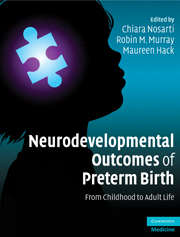Book contents
- Frontmatter
- Contents
- List of contributors
- Preface
- Section 1 Introduction
- Section 2 Neuroimaging
- Section 3 Behavioral outcome
- Section 4 Neuropsychological outcome
- 11 Cognitive and functional outcomes of children born preterm
- 12 Methodological considerations in neurodevelopmental outcome studies of infants born prematurely
- 13 Language function after preterm birth
- 14 A cognitive neuroscience perspective on the development of memory in children born preterm
- 15 Executive function development in preterm children
- Section 5 Applied research
- Section 6 Conclusions
- Index
11 - Cognitive and functional outcomes of children born preterm
from Section 4 - Neuropsychological outcome
Published online by Cambridge University Press: 06 July 2010
- Frontmatter
- Contents
- List of contributors
- Preface
- Section 1 Introduction
- Section 2 Neuroimaging
- Section 3 Behavioral outcome
- Section 4 Neuropsychological outcome
- 11 Cognitive and functional outcomes of children born preterm
- 12 Methodological considerations in neurodevelopmental outcome studies of infants born prematurely
- 13 Language function after preterm birth
- 14 A cognitive neuroscience perspective on the development of memory in children born preterm
- 15 Executive function development in preterm children
- Section 5 Applied research
- Section 6 Conclusions
- Index
Summary
Introduction
Advances in contemporary perinatal care including antenatal steroids and neonatal intensive care have resulted in continued improvement in survival of extremely low birth weight (ELBW) (< 1000 g) infants in the 1990s [1, 2–4] which has been most significant among infants at the limits of viability (23–24 weeks and < 750 g) birth weight [2, 4–8]. Approximately 40 000 ELBW infants (1% of the live births) are born annually in the United States. The goal of healthcare professionals in neonatal intensive care units (NICUs) caring for these vulnerable preterm infants is not only to assure survival, but to continually improve the neonatal and long-term neurodevelopmental outcomes of these high-risk infants. Data from the National Institute of Child Health and Human Development (NICHD) Neonatal Network indicate survival rates for ELBW infants 501–750 g improved from 41% to 55%, and for ELBW infants 750–1000 g from 81% to 86% between 1990–1 and 1997–2000 [7]. However, the number of infants with serious neonatal complications including intraventricular hemorrhage (IVH), bronchopulmonary dysplasia (BPD), and necrotizing enterocolitis (NEC), also increased during the study period. Concurrent with the increase in the total number of ELBW infant survivors, and the number of survivors with serious neonatal morbidities, there has been an increase in the total number of infants with a spectrum of post-discharge adverse neurodevelopmental outcomes requiring long-term support and intervention services.
- Type
- Chapter
- Information
- Neurodevelopmental Outcomes of Preterm BirthFrom Childhood to Adult Life, pp. 141 - 163Publisher: Cambridge University PressPrint publication year: 2010
- 5
- Cited by



